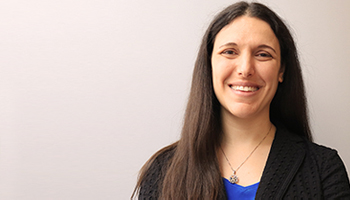HOW CAN WE HELP YOU? Call 1-800-TRY-CHOP
In This Section
Pediatric Nephrology Fellow Wins NKF's National Young Investigator's Forum Award
 The National Kidney Foundation’s National Young Investigator’s Forum proved to be a powerful and rewarding experience for Melissa Meyers, MD, for two reasons. First, she won first place in the clinical research section for her talk "Utilization of Public Health Service Increased Risk Kidneys in Pediatric Renal Transplant Recipients by Era.” Second, the third-year nephrology fellow at Children’s Hospital of Philadelphia sat in exclusive company as the only pediatrician in the room.
The National Kidney Foundation’s National Young Investigator’s Forum proved to be a powerful and rewarding experience for Melissa Meyers, MD, for two reasons. First, she won first place in the clinical research section for her talk "Utilization of Public Health Service Increased Risk Kidneys in Pediatric Renal Transplant Recipients by Era.” Second, the third-year nephrology fellow at Children’s Hospital of Philadelphia sat in exclusive company as the only pediatrician in the room.
“I was excited to talk about what kids are going through, particularly to adult practitioners,” Dr. Meyers shared. “I told the audience, ‘I want to take you in another direction and look at things through a different lens. We want to protect our kids as much as possible and offer them the best possible organs.’”
Over time, the definition of an “Increased Risk” deceased donor kidney has evolved. These kidneys are classified by the donor’s increased risk of transmitting a blood-borne infection — especially hepatitis B and C and HIV. (It should be noted, though, the donor’s serology at the time of evaluation comes back negative for all three diseases.) This broad Increased Risk category now could contain anything from a history of incarceration for more than 72 hours over the last year to IV drug use, an unfortunate result of the nation’s current opioid epidemic.
“These are relatively healthy donors with the exception of something in their medical record,” Dr. Meyers said. “They’re young and, otherwise, have low comorbidities, so we think it’s important to see how they are best utilized.”
About 20 percent of the deceased donor pool is flagged nationally as Increased Risk, Dr. Meyers said. However, in some regions, like the greater Philadelphia area, the rate jumps to nearly one-third in some years. Not only do the Centers for Disease Control and Prevention guidelines state that the recipient and/or family learn the deceased donor’s classification, they’re also entitled to know which behavior has presented the donor as Increased Risk.
“I really wanted to see how often kids receive these organs,” she said about her research project. “We have a lot of information about adults, but the landscape within the pediatric arena hasn’t been investigated in much detail.”
While Dr. Meyers described the results as “very preliminary,” her study found Increased Risk kidneys were more frequently transplanted into adult patients. Dr. Meyers’ other work has shown that pediatric recipients’ age, blood type, geographical factors, and later eras were more likely to receive an Increased Risk kidney. Dr. Meyers next wants to explore allograft outcomes and infection transmissions in the pediatric population.
Timing plays a crucial role for children in need of a kidney, stressed Dr. Meyers, noting bone and cognitive development can be impaired with extended delays.
“Every day a child waits, she can’t fulfill her full potential, and we want to set her up for success,” she said. “The idea is to preserve the safest possible kidneys for our pediatric patients, but if nearly a third of the deceased donor pool qualifies as Increased Risk in some regions, then we have to think of when we use them and how.”